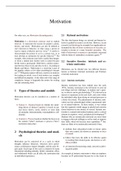Summary
Summary MOTIVATION - PSYCHOLOGY
- Course
- PSY100
- Institution
- University Of Toronto (U Of T )
it is a detailed summary of concept motivation , i have included every subtopic and concepts necessary for understanding of reader, it includes theories classical studies in psychology,and concepts,
[Show more]



